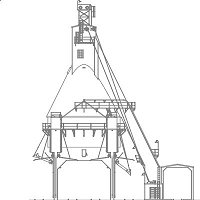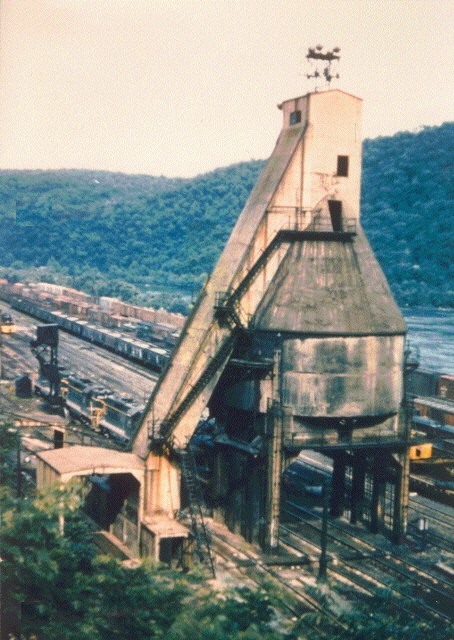Last Updated:
December 24, 2010
800
Ton
Fairbanks Morse Coal Docks
The Chesapeake & Ohio began extensive work
to modernize its physical plant in the middle and late 1920's. That effort led
to the mighty T-1 2-10-4 of 1930 and the many concrete coaling stations which
still dot the C & O although age and company efforts to clear the property of
taxable obsolete structures is beginning to make inroads. This article will
deal with only the Fulton Yard, Richmond, Virginia,
Stevens Yard, in
Kentucky (across from Cincinnati), and Hinton, West Virginia. All three yards
were redesigned in the late 1920's and very similar (if not identical)
equipment and structures were installed.
The most prominent feature of the three yards was of course the 800 ton
Fairbanks, Morse & Company coaling docks which replaced an earlier wood
ramp-style dock of 1890's vintage at Hinton and a wood elevator at
Fulton. The design of all three was
virtually the same with only minor changes. The most oblivious change was at
Fulton Yard where the skip hoist shaft was straight and not bent as at Hinton
and Stevens. The straight shaft design and wider space between the coaling
track and the fuel supply track also resulted in a different design for the
hoist house which contained the electric motors for the crusher and two skip
hoists. The crusher motor was located in the hoist house and powered the
crusher in the pit through a chain drive linkage.
The two skip hoist motors
directly powered winches which controlled cables which exited through the top
of the hoist house to cable sheaves located in the top of the coal dock
monitor. All three motors were air cooled with a air intake and exhaust
penetrating the roof or sides of the hoist house. The only other motor in the
coal dock was located in the monitor to shake the sorting grates which
separated the lump coal for "hand stampers" from stoker coal. It was also air
cooled and the air intake and exhaust were evidenced by the two approximately
8" diameter holes just below the top of the truncated cone and above the sand
bunkers.
The two skip
hoists were capable of elevating over 500 tons of coal per eight hour shift
assuming the weather was not so cold that the coal had frozen in the hoppers
which the laborers were dumping in the pit. At Hinton up to four coal dock
laborers worked the pit and two watered, coaled and sanded the engines. The
two working on fueling the engines would alternate the job of "engineer" and
laborer. In very cold weather the laborers built fires on steel plates beside
the hoppers on the fuel supply track to begin thawing the coal and then used
picks and shovels to break up the load. In the Spring, Summer and Fall the
laborers used hoses to wash the coal from the cars and keep down the dust.
</="font-size: 11pt; color: black"> In addition, the coal
docks each had two 10 ton dry sand bunkers to supply the sand boxes of
refueling engines. At Hinton in 1946 the capacity of each sand bunker was
increased by removing a part of the concrete top of each sand bunker and
adding a steel addition which increased each bunker capacity approximately 6
tons to 16 tons. The necessity for the addition is easily understood if one
takes into consideration the 8 ton capacity of the two sand boxes on the H-8
2-6-6-6's. The catwalk between the two sand bunkers was added in the 1930's
and the catwalk on the cone of the coal dock at Hinton was probably added in
1946.
Although very
massive (the eight legs of each coal dock are 3' x 2') the walls of the coal
dock and sand bunker were only 6" thick reinforced concrete and the hoist
house walls only 5" thick. Internally the Hinton and Fulton coal docks were
identical with a 200 ton lump coal bin and a 600 ton stoker coal bin. A total
of 8 coaling chutes were required to coal all four tracks from each bin. The
200 ton lump coal bin was located next to the sand bunkers and coaled all four
tracks. The 600 ton bin coaled the two center tracks from the center bay of
the coal dock and the two outside tracks from the two coaling chutes on the
opposite end from the sand bunkers. Therefore depending on whether the engine
was a
2-8-0 or 2-6-6-6, spotting
the engine for the correct type of coal was required. The coal dock at Stevens
had three internal bins - two 200 ton bins and a 400 ton bin in the center. As
a result the Stevens coal dock had a total of 12 coaling chutes so that each
bin could coal all four tracks. The reason for the difference is not known,
but may have been related to a perceived need for additional lump coal storage
due to locomotive types in the
Cincinnati area. A few notes on the drawings
are in order. The Stevens and
Fulton drawings are based upon my
measurements and photographs of the Hinton coal dock and the few Fairbanks
Morse & Company drawings which have turned up in COHS files. Therefore some of
the details have been omitted or may be incorrect depending on the limited
number of photographs of Fulton and Stevens I have had the opportunity to use.
The window show at the top of the cone is based upon the "Proposed coaling
station for Hinton" drawings which turned up in COHS files. The "window" at
Hinton is covered, but I do not know when or if the "windows" at Stevens and
Fulton were covered and therefore included the window in my drawings.
The elevated hoist house
at Stevens was added to the coal dock in 1948 probably to elevate the
electrical equipment above the flood plain. I happened to run across a drawing
bearing that date when helping to purge CSX engineering files at
Huntington circa 1986. I have not seen it
since, and the elevated hoist house and other drawings of Stevens are based
upon very limited photographic evidence. If anyone wishes to correct any
detail and provide the photographs or other evidence I will be most happy to
correct the detail. The Hinton drawings were almost complete before any
Fairbanks, Morse & Company drawings showed up in COHS files, but, so far, no
indicated dimension has been found to be off more than 3" and those have been
corrected. Should you want to add anything to the information provided, please
feel free. All the drawings are in CADD and are easily changed.
The Hinton coal dock drawings were
published in the September 1994 issue of Model Railroader at page 85 et
seq., and reference should be made to that magazine for additional details
and drawings.
Copyright 2003-2010 William E. Simonton, III

